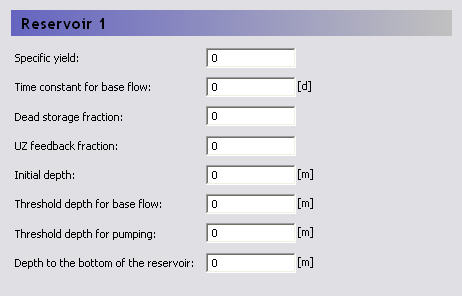


In the Linear Reservoir Method in MIKE SHE, each baseflow reservoir is divided into two parallel baseflow reservoirs. The two parallel baseflow reservoirs each receive a fraction of the percolation water from the interflow reservoirs as their only source of inflow. Each baseflow reservoir can discharge to pumping wells, to the unsaturated zone adjacent to streams and rivers (i.e. the zone beneath the lowest interflow reservoir), as well as directly to the river network.
In the primary baseflow reservoir map view, you can define the number of baseflow reservoirs in your system. You can define any number of baseflow reservoirs, but typically, there are only one or two.
For each baseflow reservoir pair, there are three items to define:
Fraction of percolation to reservoir 1 - this is used to divide the percolation between each of the two parallel baseflow reservoirs.
Fraction of pumping from reservoir 1 - this is used to divide the pumping (if it exists) between each of the two parallel baseflow reservoirs.
Use default river links - in most cases you will link the simplified overland flow and the groundwater interflow to all of the river links found in the lowest interflow reservoir in each subcatchment. However, in some cases you may want to link the flow to particular river links. For example, if your river network does not extend into the subcatchment, you can specify that the interflow discharges to a particular node or set of nodes in a nearby river network.
If you uncheck this checkbox, a River Links (V1 p. 227) sub-item will appear where you can specify the river branch and chainage to link the subcatchment to.
In the sub-dialogue for each of the parallel baseflow reservoirs, you must define the following:
Specific Yield - to account for the fact that the reservoir contains a porous media and is not an actual bathtub.
Time constant for base flow - a calibration parameter that represents the time it takes for water to flow through the reservoir
Dead storage fraction - the fraction of the received percolation that is not added to the reservoir volume but is removed from the available storage in the reservoir.
UZ feedback fraction - the fraction of base flow to the river that is available to replenish the water deficit in the unsaturated zone adjacent to the river (i.e. the lowest interflow reservoir in the subcatchment).
Initial depth - the initial depth to the water in the reservoir measured from the ground surface
Threshold depth for base flow - the depth below the ground surface when base flow stops. The threshold depth must be less than or equal to the depth to the bottom of the reservoir.
Threshold depth for pumping -the depth below the ground surface when pumping is shut off. The threshold depth must be less than or equal to the depth to the bottom of the reservoir.
Depth of the bottom of the reservoir - the depth below the ground surface of the bottom of the reservoir.
Related Items:
· Saturated Flow - Technical Reference (V1 p. 597)
· Linear Reservoir Method (V1 p. 613)
· Calculation of Baseflow (V1 p. 622)